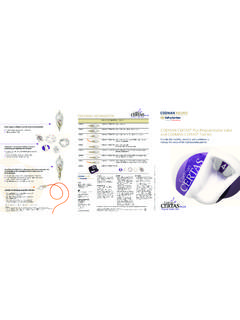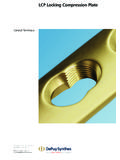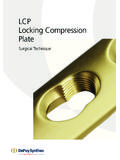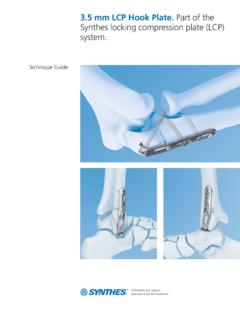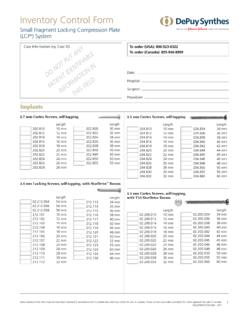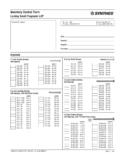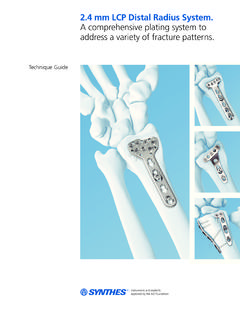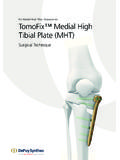Transcription of For elastic stable intramedullary nailing (ESIN) Titanium ...
1 Surgical TechniqueFor elastic stable intramedullary nailing (ESIN) Titanium / stainless steel elastic Nail SystemImage intensifier controlThis description alone does not provide sufficient background for direct use of DePuy Synthes products. Instruction by a surgeon experienced in handling these products is highly , Reprocessing, Care and MaintenanceFor general guidelines, function control and dismantling of multi-part instruments, as well as processing guidelines for implants, please contact your local sales representative or refer to: general information about reprocessing, care and maintenance of Synthes reusable devices, instrument trays and cases, as well as processing of Synthes non-sterile implants, please consult the Important Information leaflet (SE_023827) or refer to.
2 Technique Titanium / stainless steel elastic Nail System DePuy Synthes 1 Table of ContentsIntroduction TEN/STEN System 2 Indications and Contraindications 4 Clinical Cases 5 Biomechanical Principle of elastic stable intramedullary nailing (ESIN) 9 Surgical Technique for Standart Indications Femur Ascending Technique (pediatrics only) 12 Femur Descending Technique (pediatrics only) 29 Tibia Descending Technique (pediatrics only) 31 Forearm 33 Humerus Ascending Technique 46 Humerus Descending Technique 47 Surgical Technique for Extended Indications Proximal Radius: radial neck 48 Distal Radius and Ulna diaphyseal metaphyseal, displaced fractures 49 Clavicle 50 Product Information Implants 52 Instruments 53 Setlist Modular Trays TEN System 55 Bibliography 57 MRI Information 58 TEN/STEN System.
3 For elastic stable intramedullary implants for stable fixationTEN end caps Two sizes of end caps to cover all nail diameters Sharp self-cutting thread for fixation in bone Reduces the risk of nail back out Reduces the risk of soft-tissue irritation Facilitate implant removalNail tip Facilitates nail insertion and sliding along the medullary canalNail diameters Six nail diameters for all indications Available in Titanium alloy (Ti-6Al-7Nb) or stainless steelNail marking Allows direct visual control of the alignment of the nail tip in the medullary canalFor nail mmFor nail mmSurgical Technique Tit anium/ stainless steel elastic Nail System DePuy Synthes 1 Sophisticated instruments for facilitated handlingInserter for TEN Facilitates nail insertion and advancement in the medullary canal Marking on instrument indicates nail tip orientation in the medullary canal Hammer guide allows controlled blows on the inserterAwl for TEN Sharp tip facilitates entry to the medullary canal Curved awl simplifi es the access to the clavicle.
4 Radius and ulna and helps avoid penetration of the bilateral cortexExtraction pliers for TEN Secure grasping hold of the nails with the tip of the pliers Hammer guide use facilitates nail extractionCutter for TEN Allows precise and smooth cutting of the nail Can be used close to the skin without damaging the soft-tissues All nail diameters can be cutImpactor for TEN Controlled and precise end placement of elastic nail thanks to the specifi c depths of the holes at the tips of the corresponding impactors Facilitates positioning and fi xation of all sizes of end caps Bevelled (large/small) or straight impactors are avail-able4 DePuy Synthes Titanium / stainless steel elastic Nail System Surgical TechniqueIndications in PediatricsElastic stable intramedullary nailing (ESIN) with the Tita-nium elastic Nail (TEN) or stainless steel Nail (STEN) is in-dicated for the management of diaphyseal and certain metaphyseal/ epiphyseal fractures of long bones in chil-dren and young follows.
5 Diaphyseal and certain metaphyseal fractures of long bones certain metaphyseal/-epiphyseal fractures (Salter Harris I and II), including but not limited to radial neck frac-tures complex clavicular fractures (significant dislocation including shortening, floating shoulder ) open fractures threat of skin perforation at fracture ends pathologic fracturesIndications in AdultsIn adult patients, TEN is used for the osteosynthesis of clavicle, forearm and humerus follows: diaphyseal fractures of long bone fractures in upper extremity clavicle shaft fractures ContraindicationsNo specific and ContraindicationsSurgical Technique Titanium / stainless steel elastic Nail System DePuy Synthes 5 PreoperativePostoperativeFollow-upClinic al Cases Case 1: Pediatric Femur Ascending Technique with End CapCase 2: Pediatric Femur Ascending Technique with End CapPreoperativeFollow-upPostoperative6 DePuy Synthes Titanium / stainless steel elastic Nail System Surgical TechniqueCase 4: Pediatric Humerus Ascending TechniquePreoperativePostoperativeFollow -upCase 3.
6 Pediatric TibiaClinical CasesPreoperativeFollow-upPostoperativeS urgical Technique Titanium / stainless steel elastic Nail System DePuy Synthes 7 PreoperativePostoperativeFollow-upCase 5: Pediatric Humerus Descending TechniquePreoperativePostoperativeFollow -upCase 6: Pediatric Radius and Ulna R. Antegrade /U. Antegrade8 DePuy Synthes Titanium / stainless steel elastic Nail System Surgical TechniqueCase 8: Pediatric Radius Neck PreoperativeReductionFollow-upClinical CasesCase 7: Pediatric Radius and Ulna R. Antegrade /U. Retrograde with End CapPreoperativePostoperativeFollow-upSur gical Technique Titanium / stainless steel elastic Nail System DePuy Synthes 9 RFSCSCFFFFFFRRRRRRRRB iomechanical Principle of elastic stable intramedullary nailing (ESIN)The elastic flexible nails are bent and inserted into the medullary canal.
7 This elastic deformation within the medullary canal creates a bending moment within the long bone that is not rigid, but that is stable enough to reduce and fix the fracture 1, 2. 1 Dietz HG, Schmittenbecher P, Illing P (1997) Intramedull re Osteosynthese im Wachstumsalter. M nchen: Urban und Dietz HG, Schmittenbecher P, Slongo T, Wilkins K (2006) elastic stable intramedullary nailing (ESIN) in Children. AO Manual of Fracture Management. New York: stabilityTranslational stabilityRotational stabilityAxial stabilityF = force acting on the boneR = restoring force of the nailS = shear forceC = compressive force11 DePuy Synthes Titanium / stainless steel elastic Nail System Surgical TechniqueBABABone healingThe development of the ESIN technique is based on the aim of achieving rapid bone healing, while respecting all the child-specific bone-healing properties.
8 In children, osteo- blasts in the inner cellular layer of the thick perios-teum are able to build new bone more rapidly. Later in life, as the periosteum becomes thinner, the bone-heal-ing process is prolonged in line with the patient s age. This method thus preserves the periosteum allowing a rapid bone healing in modelThe double-frame model illustrates the principle of the ESIN technique. The inner frame consists of the medul-lary canal containing the elastic flexible nails and the bone (A in 1 and 2), where-as the muscles on the ante-rior/posterior, medial/lateral sides form the outer frame (B in 1 and 2). Both frames have to be functional in or-der to provide suf ficient stability for reducing and main-taining fracture reduction.
9 ExceptionsIn the tibia, the application of the principle of ESIN is more demanding because of the missing outer frame, and muscle coverage on the medial and lateral sides. In the clavicle, the elastic nails are used to treat certain fractures. However, no standard ESIN technique is ap-plied, but rather the elastic nail is used, because it adapts to the special anatomic features of the Aspects of elastic stable intramedullary nailing (ESIN)Figure 1 Figure 2 Surgical Technique Titanium / stainless steel elastic Nail System DePuy Synthes 11 The following section describes the principally used sur-gical techniques. In general, careful preoperative plan-ning, correct choice of implant and a precise rotational check on the basis of the non-operated extremity are all crucial for a successful clinical Technique for Standard Indications11 DePuy Synthes Titanium / stainless steel elastic Nail System Surgical Technique12 Femoral fractures in children are typically stabilized with two nails of identical diameter, inserted in a retrograde manner from medial and lateral entry points above the distal physis.
10 Antegrade nailing , with a lateral entry point for both nails, is normally reserved for very distal femoral technique guide describes the more common retro-grade technique in detail. For femoral fractures in chil-dren of average stature, use of mm, mm or mm diameter nails is recommended according to the patient anatomy. The use of end caps further increases the axial stability, protects the soft-tissue from irritation and facilitates subsequent implant Ascending Technique(pediatrics only)1. Position the patientPlace the child in a supine position on a radiolucent opera ting table (1). The fracture table (2) can be used for larger small children to the operating table. The assis-tant extends the injured extremity.
